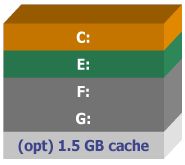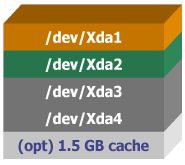The Rembo Wizard
is an automation tool build on the Rembo Toolkit with following build-in
assumptions about the target PC computer:
- Operating system is Windows 95/98/NT/2000/XP or Linux (distributions
from RedHat and SuSE have been tested)
- The entire operating system is installed on the first partition of
the first disk
Partitioning details
A flat, four primary partitioning is supported. Logical partitions are
not supported. If multicast techniques will be used, at least 1.5 GB
should be reserved at the end of the disk non-partitioned. It will be used
automatically by Rembo for caching purposes.
 Windows:
It is recommended that C: drive contains only system files. Arrange so
that the second partition (assigned probably with drive letter E:) will
contain end-user's data files.
The Rembo Wizard will
not back up or alter the contents of the E: disk. Optionally you
can have other primary partitions configured on your hard disk.
The Rembo Wizard will
register them in its partition table signature but it will not alter the
contents. If the C: is NTFS and the operating system is 2000/XP the
installation may contain compressed and even encrypted files. Rembo is not
capable to backup these types of files. Read this
note from Rembo before deploying
The Rembo Wizard
first time on these types of systems. If 2000/XP is installed on a
SCSI-disk, there automatic removal of the old hard disk information and
the automatic add-on of the new hard disk information will not work but
you may have to manually edit this information once the system has
started. Windows:
It is recommended that C: drive contains only system files. Arrange so
that the second partition (assigned probably with drive letter E:) will
contain end-user's data files.
The Rembo Wizard will
not back up or alter the contents of the E: disk. Optionally you
can have other primary partitions configured on your hard disk.
The Rembo Wizard will
register them in its partition table signature but it will not alter the
contents. If the C: is NTFS and the operating system is 2000/XP the
installation may contain compressed and even encrypted files. Rembo is not
capable to backup these types of files. Read this
note from Rembo before deploying
The Rembo Wizard
first time on these types of systems. If 2000/XP is installed on a
SCSI-disk, there automatic removal of the old hard disk information and
the automatic add-on of the new hard disk information will not work but
you may have to manually edit this information once the system has
started.
 Linux:
The Rembo Wizard
supports installation both on SCSI and on IDE disk. The "X" on the
diagram can therefore be either "h" or "s". The first partition is
supposed to contain the entire Linux installation, the "/". The second
partition should be a Linux swap partition. Optionally you can have other
primary partitions configured on your hard disk.
The Rembo Wizard will
register them in its partition table signature but it will not alter the
contents. Arrange so, that the end-user's data will be stored on these
partitions, on a NFS-server but not on the root partition. Linux:
The Rembo Wizard
supports installation both on SCSI and on IDE disk. The "X" on the
diagram can therefore be either "h" or "s". The first partition is
supposed to contain the entire Linux installation, the "/". The second
partition should be a Linux swap partition. Optionally you can have other
primary partitions configured on your hard disk.
The Rembo Wizard will
register them in its partition table signature but it will not alter the
contents. Arrange so, that the end-user's data will be stored on these
partitions, on a NFS-server but not on the root partition.
|
